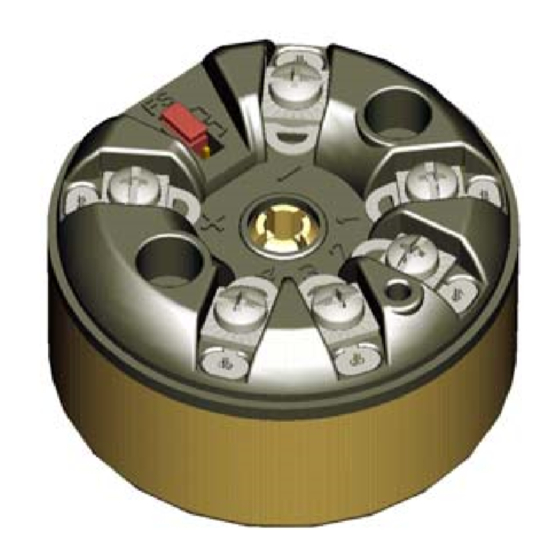
Summarization of Contents
OVERVIEW
1.1 INTRODUCTION
Provides a general overview of the STT250 Smart Temperature Transmitter.
TECHNICAL SPECIFICATIONS
2.1 ENVIRONMENTAL CONDITIONS
Details the operating and storage conditions for the transmitter.
2.1.1 Physical Specifications
Describes the physical dimensions and variations of the STT250.
THEORY OF OPERATION
3.1 BASIC OPERATION
Explains the fundamental working principles of the STT250 transmitter.
3.2 CONFIGURATION TOOLS
Outlines the tools used for configuring the transmitter, including SFC, HART, and SCT.
3.2.1 Smart Field Communicator (SFC)
Details the functionality and supported commands of the SFC.
3.2.2 HART Communicator (model 275)
Explains communication via the HART protocol using the model 275 communicator.
3.2.3 Smartline Configuration Toolkit (SCT)
Describes the use of the SCT for configuring DE protocol transmitters.
BENCH CHECK INSTALLATION/COMMISSIONING
4.1 UNPACKING
Instructions for unpacking and verifying the contents of the STT250.
4.2 EQUIPMENT
Lists the necessary equipment for bench testing the transmitter.
4.3 INSTALLATION
Provides guidance on connecting equipment for bench installation.
4.4 GROUNDING AND SHIELDING TECHNIQUES
Covers methods for proper grounding and shielding to prevent noise.
4.5 STT250 CONFIGURATION
Steps and procedures for configuring the STT250 transmitter settings.
4.5.1 Analog Output Configuration (based on STS103)
Guides through configuring the analog output using the SFC.
4.5.2 DE Digital Output Configuration
Details the process of configuring the transmitter for digital DE output.
4.5.3 HART Configuration
Instructions for configuring the transmitter using the HART protocol.
4.6 MOUNTING
Information and methods for mounting the STT250 transmitter.
4.6.1 DIN Rail Mounting
Specific steps for mounting the STT250 on a DIN rail.
4.6.2 Mounting Module in Housing
Describes different housing options for mounting the transmitter.
4.7 COMMISSIONING
Procedures for verifying and setting up the transmitter after installation.
4.8 START UP
Steps for safely starting up and testing the transmitter in operation.
MAINTENANCE/TROUBLESHOOTING
5.1 MAINTENANCE
Guidelines for routine maintenance of the STT250 transmitter.
5.2 TROUBLESHOOTING
Procedures and common issues for diagnosing and resolving problems.
5.2.1 Troubleshooting with SFC
Troubleshooting the STT250 loop using the Smart Field Communicator (SFC).
5.2.2 Troubleshooting with HART communicator
Troubleshooting the STT250 loop using a HART communicator.
5.3 RECOMMENDED PARTS
A list of recommended spare and replacement parts for the STT250.
5.4 WIRING AND INSTALLATION DRAWINGS NUMBERS
References to specific drawing numbers for wiring and installation.
INDICATION METERS
6.1 INTRODUCTION
Overview of integral meters supplied with the transmitter.
6.2 CONNECTION INFORMATION
Details on how to wire the meters in the loop.
6.3 INSTALLATION/COMMISSIONING
Steps for installing and commissioning the indication meters.
6.3.1 Transmitter Operating in 6 Byte Output Mode
Configuration for 6-byte digital DE output mode for meters.
6.3.2 Transmitter Operating in 4 Byte Digital Output or in 4-20 mA Analog Mode
Configuration for 4-byte digital DE or 4-20 mA analog modes.
6.3.3 Transmitter Operating in 4-20 mA Analog Output Mode
Specifics for configuring meters with 4-20 mA analog output.
6.4 DIAGNOSTIC AND TROUBLESHOOTING
How to diagnose and troubleshoot issues with indication meters.
6.4.1 Analog Meter
Troubleshooting specific to the analog meter.
6.4.2 Smart Meter
Diagnosis and troubleshooting for the Smart Meter.
6.4.2.1 Failed self test
Actions to take if the Smart Meter's self-test fails.
6.4.2.2 Meter Fault Conditions
Common fault conditions and their corrective actions for Smart Meters.
6.4.3 4-20 mA Analog Mode Calibration of Smart Meter
Procedure for calibrating the Smart Meter for 4-20 mA analog signals.
APPENDIX A TRANSIENT PROTECTOR INSTALLATION INSTRUCTION
A.1 OVERVIEW
Introduction to Honeywell's transient protectors for STT 3000 transmitters.
A.2 FEATURES AND BENEFITS
Describes the protective features and advantages of the transient protectors.
A.3 ELECTRICAL CHARACTERISTICS
Lists the electrical specifications of the transient protectors.
A.4 INSTALLATION PROCEDURE
Step-by-step guide for installing the transient protector.
A.5 WIRING REFERENCE
Provides a typical wiring diagram for transient protector connections.











Need help?
Do you have a question about the STT25M and is the answer not in the manual?
Questions and answers